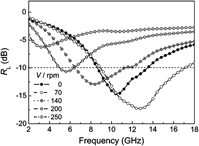Crossref Citations
This article has been cited by the following publications. This list is generated based on data provided by
Crossref.
Tong, Guoxiu
Wu, Wenhua
Guan, Jianguo
Wang, Jianping
Ma, Ji
Yuan, Jinhao
and
Wang, Sunli
2011.
Solution synthesis and novel magnetic properties of ball-chain iron nanofibers.
Journal of Materials Research,
Vol. 26,
Issue. 20,
p.
2590.
Tong, Guo-Xiu
Yuan, Jin-Hao
Ma, Ji
Guan, Jian-Guo
Wu, Wen-Hua
Li, Liang-Chao
and
Qiao, Ru
2011.
Polymorphous Fe/FexOy composites: One-step oxidation preparation, composition control, and static magnetic and electromagnetic characteristics.
Materials Chemistry and Physics,
Vol. 129,
Issue. 3,
p.
1189.
Tong, Guoxiu
Hu, Qian
Wu, Wenhua
Li, Wei
Qian, Haisheng
and
Liang, Yan
2012.
Submicrometer-sized NiO octahedra: facile one-pot solid synthesis, formation mechanism, and chemical conversion into Ni octahedra with excellent microwave-absorbing properties.
Journal of Materials Chemistry,
Vol. 22,
Issue. 34,
p.
17494.
Tong, Guoxiu
Yuan, Jinhao
Wu, Wenhua
Hu, Qian
Qian, Haisheng
Li, Liangchao
and
Shen, Jiaping
2012.
Flower-like Co superstructures: Morphology and phase evolution mechanism and novel microwave electromagnetic characteristics.
CrystEngComm,
Vol. 14,
Issue. 6,
p.
2071.
Zhang, Shuyuan
and
Cao, Quanxi
2012.
Electromagnetic and microwave absorption performance of some transition metal doped La0.7Sr0.3Mn1−xTMxO3±δ (TM=Fe, Co or Ni).
Materials Science and Engineering: B,
Vol. 177,
Issue. 9,
p.
678.
Tong, Guo-Xiu
Wu, Wen-Hua
Hu, Qian
Yuan, Jin-Hao
Qiao, Ru
and
Qian, Hai-Sheng
2012.
Enhanced electromagnetic characteristics of porous iron particles made by a facile corrosion technique.
Materials Chemistry and Physics,
Vol. 132,
Issue. 2-3,
p.
563.
Tong, Guo-Xiu
Du, Fang-Fang
Liang, Yan
Hu, Qian
Wu, Ruo-Nan
Guan, Jian-Guo
and
Hu, Xian
2013.
Polymorphous ZnO complex architectures: selective synthesis, mechanism, surface area and Zn-polar plane-codetermining antibacterial activity.
J. Mater. Chem. B,
Vol. 1,
Issue. 4,
p.
454.
Yang, Ruey-Bin
Liang, Wen-Fan
Choi, Siu-Tong
and
Lin, Chung-Kwei
2013.
The Effects of Size and Shape of Iron Particles on the Microwave Absorbing Properties of Composite Absorbers.
IEEE Transactions on Magnetics,
Vol. 49,
Issue. 7,
p.
4180.
Zou, J.
Liu, Q.
Zi, Z.
and
Dai, J.
2014.
Enhanced electromagnetic wave absorption properties of planar anisotropy carbonyl-iron/Fe3O4 composites in gigahertz range.
Materials Research Innovations,
Vol. 18,
Issue. sup2,
p.
S2-304.
Wen, Shulai
Liu, Ying
Zhao, Xiuchen
Cheng, Jingwei
and
Li, Hong
2014.
Synthesis, multi-nonlinear dielectric resonance and electromagnetic absorption properties of hcp-cobalt particles.
Journal of Magnetism and Magnetic Materials,
Vol. 354,
Issue. ,
p.
7.
Du, Fangfang
Tong, Guoxiu
Tong, Chaoli
Liu, Yun
and
Tao, Jianqing
2014.
Selective synthesis and shape-dependent microwave electromagnetic properties of polymorphous ZnO complex architectures.
Journal of Materials Research,
Vol. 29,
Issue. 5,
p.
649.
Zhao, Biao
Shao, Gang
Fan, Bingbing
Xie, Yajun
Wang, Binbin
and
Zhang, Rui
2014.
Solvothermal synthesis and electromagnetic absorption properties of pyramidal Ni superstructures.
Journal of Materials Research,
Vol. 29,
Issue. 13,
p.
1431.
Senapati, Samarpita
Srivastava, Suneel Kumar
Singh, Shiv Brat
and
Kulkarni, Ajit R.
2014.
SERS active Ag encapsulated Fe@SiO2 nanorods in electromagnetic wave absorption and crystal violet detection.
Environmental Research,
Vol. 135,
Issue. ,
p.
95.
Khan, Kishwar
and
Rehman, Sarish
2014.
Microwave absorbance properties of zirconium–manganese substituted cobalt nanoferrite as electromagnetic (EM) wave absorbers.
Materials Research Bulletin,
Vol. 50,
Issue. ,
p.
454.
Tong, Guoxiu
Liu, Yun
Liu, Fangting
and
Guan, Jianguo
2015.
Easy gas-flow-induced CVD synthesis and tunable electromagnetic characteristics of centipede-shaped iron/cementite/multiwalled carbon nanotube (Fe/Fe3C/MWCNT) heterostructures.
Surface and Coatings Technology,
Vol. 283,
Issue. ,
p.
286.
Reshi, Hilal Ahmad
Singh, Avanish P.
Pillai, Shreeja
Yadav, Rama Shankar
Dhawan, S. K.
and
Shelke, Vilas
2015.
Nanostructured La0.7Sr0.3MnO3compounds for effective electromagnetic interference shielding in the X-band frequency range.
Journal of Materials Chemistry C,
Vol. 3,
Issue. 4,
p.
820.
Tong, Chaoli
Liu, Yun
Du, Fangfang
Tong, Guoxiu
and
Li, Liangchao
2015.
Enhanced microwave electromagnetic characteristics of porous ZnO/Ni/Zn NiyFe3−x−yO4 hybrid micro-hexahedra.
Materials Chemistry and Physics,
Vol. 163,
Issue. ,
p.
1.
Yang, Peipei
Liu, Ying
Zhao, Xiuchen
Cheng, Jingwei
and
Li, Hong
2016.
Electromagnetic wave absorption properties of FeCoNiCrAl0.8 high entropy alloy powders and its amorphous structure prepared by high-energy ball milling.
Journal of Materials Research,
Vol. 31,
Issue. 16,
p.
2398.
Ye, Yucheng
Zhao, Yanting
Ni, Liuliu
Jiang, Kedan
Tong, Guoxiu
Zhao, Yuling
and
Teng, Botao
2016.
Facile synthesis of unique NiO nanostructures for efficiently catalytic conversion of CH4 at low temperature.
Applied Surface Science,
Vol. 362,
Issue. ,
p.
20.
Jiang, Kedan
Liu, Yun
Pan, Yefei
Wang, Ru
Hu, Panbing
He, Rujia
Zhang, Lingli
and
Tong, Guoxiu
2017.
Monodisperse Ni x Fe 3-x O 4 nanospheres: Metal-ion-steered size/composition control mechanism, static magnetic and enhanced microwave absorbing properties.
Applied Surface Science,
Vol. 404,
Issue. ,
p.
40.





